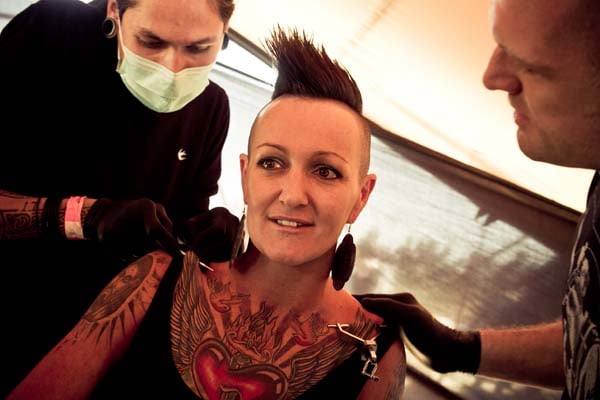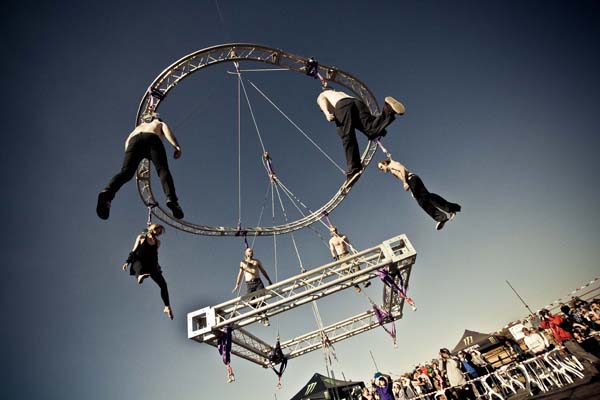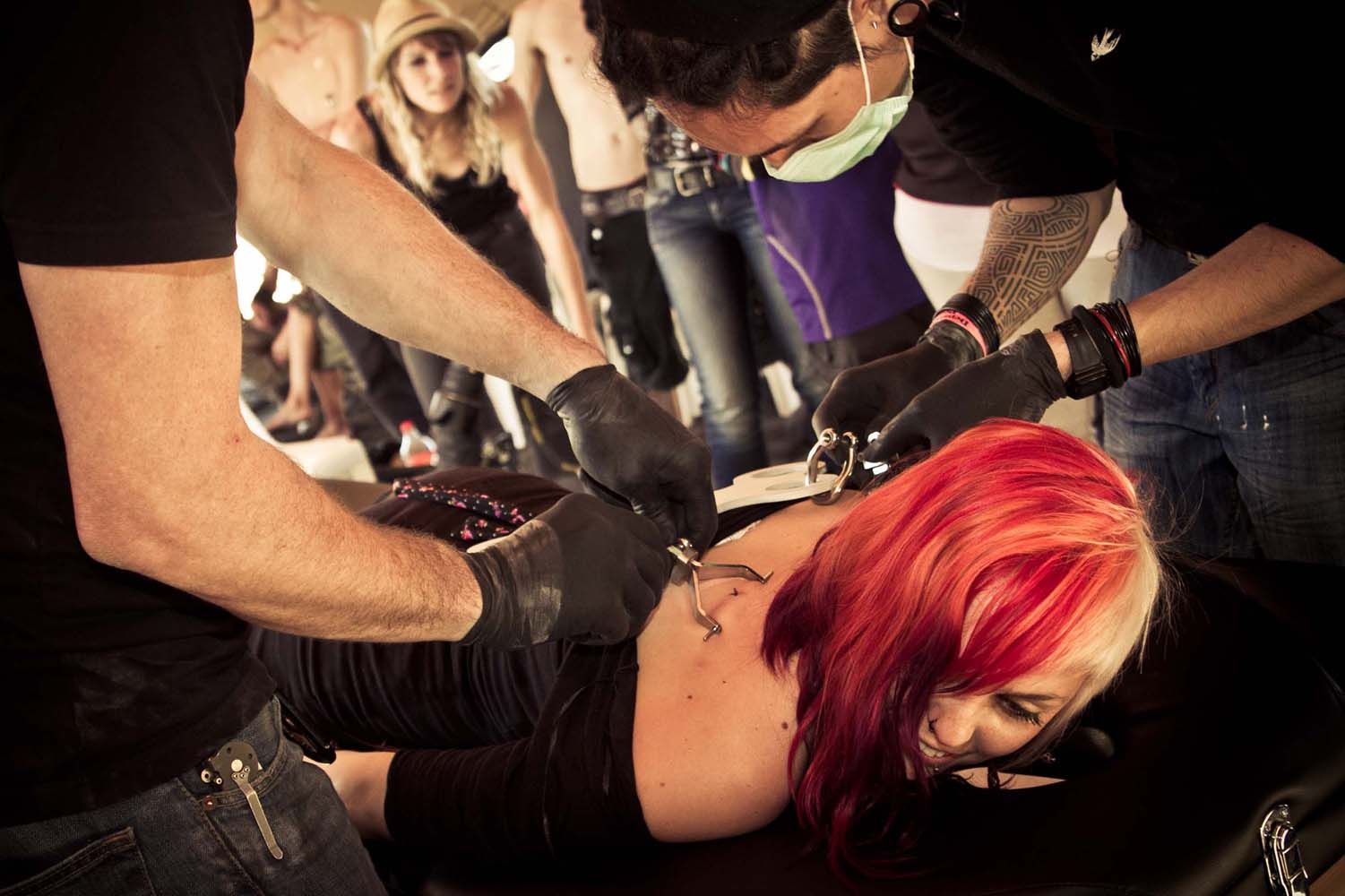Participants were forbidden meat in the days running up to the event to make their skin more elastic. (Sigrun Wagner)
The tattooed, pierced women and men float gently, moving their limbs in a slow treading motion. But there's no water buoying them up. Instead, they hang from rods pushed through the bare skin on their backs, their feet cycling through empty air, 25m off the ground.
Dubbed "the human chandelier", the metal structure involves a series of metal circles and squares decreasing in size, suspended from a crane. On each level hang people, swinging from chains attached to the rods in their upper backs. The set-up leads to a slumped look that gives this form of suspension its name: the suicide position.
The 13 suspended in the air on this cold but sunny Johannesburg Sunday morning on a tract of land in Midrand are trying to break a world record.
The previous record, as far as one of the organisers, Royston Chapman, can tell, was nine people.
Chapman and a core group organised "suspension days" in the run-up at friends' houses to ensure the newbies in the group were ready, and forbade the group of 13 from eating meat.
"Your skin becomes more elastic and there is less bruising afterwards," he said.

One of the participants at the fourth Johannesburg Tattoo Expo, Cool Inc, in Midrand. (Sigrun Wagner)
It was important to suspend on a full stomach. "If you haven't eaten anything, the adrenaline spike can actually send you into shock," Chapman said. The suspendees also kept moving while in the air, to prevent shock.
Their intensive planning was rewarded: the nine medics present in case of emergency were left with little to do.
Life-threatening stunt
But the group will never be entirely sure whether theirs was a record, despite positive feedback from global suspension groups. The Guinness World Records declined to record the event, as it constituted a potentially life-threatening stunt.
What the group did get was a collection of surreal photographs that were passed around social networks after the event, which took place at the fourth Johannesburg Tattoo Expo, Cool Inc.
"It hurt about as much as you think it would," said one of the 13, sculpture artist Sybrand Wiechers. "Anyone who says it doesn't hurt is lying."
He was an exception at Sunday's event, a stranger to the scene, sporting neither tattoos nor piercings. It was his first suspension.
"The first time you see the crane, the reality of it kicks in, and you go, 'Am I completely stupid?'" he said. There were three moments when the pain was most acute for Wiechers: when the rods went in – "there are no endorphins running yet to help you"; the moment his feet left the ground and he felt his body's full weight; and when he was lowered.

Participants said they felt euphoric once the pain wore off, but the spiritual purpose of the practice, an age-old custom in some cultures, did not appear to be the primary motivation. (Sigrun Wagner)
But in his 15 airborne minutes, things were different. "It took a while for the endorphins to kick in, though in the end they must have, because I wasn't in that much pain," he said. Others have described feeling euphoric to the point of weeping, or utterly in control.
Modern-day suspension isn't new. It reached its heyday in South Africa in the late 1990s, when Svend Jensen was purportedly the first South African to be hoisted up. Fifteen years later, he is working to make the practice more acceptable to the person on the street, and was part of Sunday's crew.
Back then, it was an era of hallucinogens, raves and, most importantly, body modification. As the country's borders opened up post-1994, previously banned literature flooded into the country. A subculture formed around tattooing, piercing, branding (burning images on to the skin), scarification and suspensions. The participants were mostly white: alternative individuals who never fitted in under apartheid and weren't quite sure where they stood after it.
Euphoric rush
"It was very related to the drug scene and S&M," said journalist Charl Blignaut, who documented the subculture as he participated in it.
They were a generation seeking… something: enlightenment, overcoming their fear, the euphoric rush that comes with the adrenaline release associated with extreme pain. There were no set answers.
Suspending a person is a science. Get it wrong, and the hooks could unbend and the person fall, or even rip their skin.
Conrad Feldman, a body modifying artist, formed a company with Jensen called Pendeo to handle the technical aspects. Gone are the fishhooks and rudimentary set-up of the early years. Pendeo uses 5mm-thick rods driven through the skin, after an initial piercing, connected to a plate that is hooked to the suspension chain. It is a clean, clinical process involving surgical gloves and little blood.
It is a far cry from ancient forms of suspension in other cultures, most notably the South American Mandan tribes, who suspended would-be warriors as a rite of passage, and the Hindu ritual of vel kavadi.
"It is based on the idea that by subordinating the physical to the mental, one will achieve greater spiritual strength," said University of KwaZulu-Natal school of religion professor Pratap Kumar about the latter ritual.
"The modern phenomenon of suspending one's body may not have this spiritual dimension."
Cultural appropriation
Indeed, the South African group has no strong links with the philosophy associated with ancient rites or the communities that still practise them. Even its claim that Jensen was the first person suspended in the country is divorced from the Tamil community in South Africa, which still engages in piercings with hooks.
"I have travelled in India, seen the guys with spikes in their back, but have never been involved," said Chapman, whereas Feldman said it was all linked: "The way I see it, spirituality really has nothing to do with religion and more to do with oneself."

Human suspendees at the fourth Johannesburg Tattoo Expo, Cool Inc, in Midrand last Sunday, were hung by 5mm thick rods driven through the skin, connected to a metal plate. (Sigrun Wagner)
Charges of cultural appropriation don't go down well. An international community of suspendees address the question in the FAQs on their website.
"No culture can 'patent' suspension and ask others not to be involved with it," it says. "As most of us are neither Native American nor Hindu, we can not reasonably understand the nuances of their rituals, and by attempting to replicate them, we produce at best a shallow copy that insults everyone involved."
But those from the original scene in South Africa may disagree.
"Quite frankly, if you are setting records you are on the wrong spiritual track," said Blignaut.
For Wiechers, at least, it was worth it. "The only actual danger is fear," he said. "You can't give over to your body's response to it because it can kill you. So it has that slight transcendent aspect to it."
And that's probably the most spiritual most modern suspendees will get on the subject, begging the question, as the Atlantic put it in a recent article, whether this is not hanging for the sake of hanging.